
Cerenovus recently announced that it has launched Stroke Solutions, which includes a suite of three devices designed to aid physicians in clot removal procedures. The announcement was made during the virtual European Society of Minimally Invasive Neurological Therapy (ESMINT; 9–11 September, Virtual)
Strokes are the second leading cause of death globally, with estimates suggesting that by 2035 the number of stroke deaths across Europe will increase by 45%. Over half of stroke survivors become chronically disabled,1 placing an economic strain on healthcare systems. In the European Union alone the total cost of stroke was estimated at €45 billion in 2015.
Cerenovus, which is part of Johnson & Johnson Medical Devices Companies, says that its stroke solutions were designed to help physicians perform mechanical thrombectomy procedures.
The suite of technologies includes:
CEREBASE DA Guide Sheath, a long guide sheath, which aims to give more trackability and support to allow physicians to navigate challenging anatomy and secure Distal Access for Geometric Anchoring;
EMBOVAC Catheter, which is designed for atraumatic vessel wall interaction to balance trackability with more durability and compatibility. Featuring excellent distal kink resistance in a thin wall design, it allows rapid navigation to the middle cerebral artery based on anatomically optimised design;
And lastly, EMBOTRAP III Revascularisation Device: The latest generation stent retriever, is designed to engage a wide range of clot types, improve procedural confidence and provide more tailored options to achieve the First Pass Effect (FPE). FPE is an independent predictor of good functional outcome and has resulted in faster patient recovery times, which may translate to lower healthcare costs.8
“Stroke is a silent killer that can take a life within minutes, and we designed Cerenovus Stroke Solutions to support physicians in successfully treating their patients efficiently and effectively,” said Mark Dickinson, Worldwide President of Cerenovus. “We are committed to developing differentiated solutions based on physicians’ real-world experiences to change the trajectory of stroke care”, he adds.
The company will present interim data from the EXCELLENT registry at ESMINT and will be focused on the composition of the clots collected. This research on clot science continues to provide the foundation used to inform the design of the company’s stroke solutions.
“Not all mechanical thrombectomy procedures are equal and the greatest benefits to patients are observed when reperfusion is achieved from the first pass,” said Professor Kyriakos Lobotesis, Imperial College Healthcare NHS Trust, UK, principal investigator in the EXCELLENT study. “The EXCELLENT registry is a unique study that goes beyond reporting patient outcomes and helps to understand more about clot composition, revascularisation rates and clinical outcomes.”









